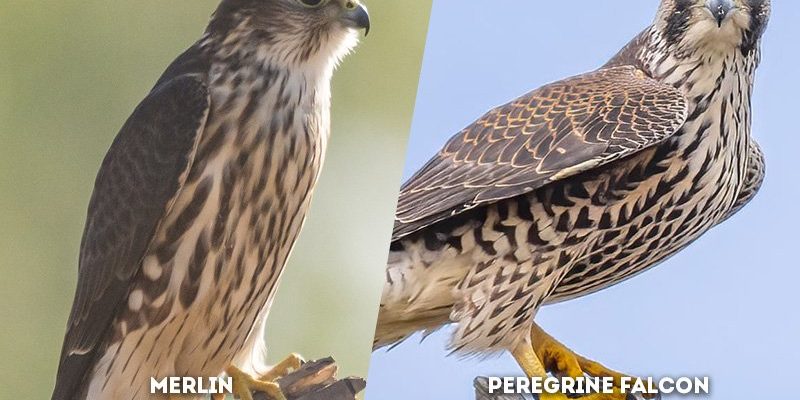![Comparing The Peregrine Falcon Vs. [Similar Species]](https://gudri.com/wp-content/uploads/2025/06/Comparing_The_Peregrine_Falcon_Vs___Similar_Species__image_0-1.jpg)
Physical Characteristics: Size and Appearance
When it comes to physical characteristics, the differences between the Peregrine Falcon and the American Kestrel are quite striking. The Peregrine Falcon is a large bird, typically measuring about 15 to 20 inches in length, with a wingspan of around 40 inches. Its plumage features a handsome slate-gray color on the back, contrasting sharply with its white and cream-colored underbelly. You might notice dark stripes on its face, giving it a fierce, streamlined look.
On the other hand, the American Kestrel is much smaller, averaging about 9 to 12 inches in length and boasting a wingspan of around 22 inches. Its colorful feathers include a rust-colored back and a vibrant blue-gray head. This little bird’s charming appearance makes it one of North America’s most beloved raptors. The differences in size and color aren’t just for show; they play significant roles in how each bird hunts and survives in the wild.
Adaptations and Hunting Techniques
Both birds have fascinating adaptations that enhance their hunting skills, but they do so in very different ways. The Peregrine Falcon is a master of speed. It can dive at speeds of over 240 miles per hour, making it the fastest creature on Earth. This breathtaking speed allows it to catch its favorite prey—other birds—on the wing. Their specialized vision helps them spot potential targets from high altitudes, and once they’re locked in, there’s little that can escape their grasp.
Meanwhile, the American Kestrel employs a different hunting strategy. Instead of chasing its prey at breakneck speeds, the kestrel often hunts from a perch, scanning the ground for small rodents or insects. You might catch one hovering in mid-air, using its keen eyesight to spot prey below. This hovering ability is thanks to its unique wing shape and flight pattern, making it an efficient hunter in open areas and fields.
Habitats and Range
Let’s talk about where you might find these two raptors. The Peregrine Falcon is quite the globetrotter. You can find it in various habitats, ranging from urban environments to coastal cliffs and open fields. These birds are incredibly adaptable and have made their homes in cities, where tall buildings mimic their natural cliff-side nests. They tend to reside in nearly every continent except Antarctica, which speaks volumes about their resilience.
In contrast, the American Kestrel prefers more specific habitats. You’ll often find these little falcons in open fields, grasslands, and even agricultural areas. They thrive in regions where they can easily find insects and small mammals to eat. While kestrels are also widespread across North America, they tend to stick to areas with plenty of open space and perches for hunting.
Behavior and Social Structure
Now, let’s dive into their behavior. The Peregrine Falcon is known for its solitary nature, often hunting and nesting alone or with one mate. When breeding season rolls around, they become incredibly devoted partners. The males and females work together to raise their young, taking turns hunting and caring for the nest. Watching them take flight together can be a heartwarming sight.
On the other hand, the American Kestrel can often be seen socializing more actively. During mating season, males can be quite flashy, performing aerial displays to attract females. They also don’t mind nesting in more communal settings, sometimes sharing space with other kestrels. While they can be solitary hunters, they may also be spotted in pairs, especially during migration or in search of food.
Diet and Feeding Habits
When it comes to what these birds eat, their diets reflect their unique hunting styles and habitats. The Peregrine Falcon primarily feeds on other birds. They are skilled hunters, targeting everything from pigeons to smaller songbirds. With that remarkable speed, they can swoop down and capture their lunch mid-flight. It’s a fascinating display of power and precision.
In contrast, the American Kestrel has a more varied diet. While they also eat small birds, they are heavily reliant on insects and small mammals, like voles and grasshoppers. Their feeding habits show their adaptability; they can hunt from a perch or in mid-air, making them successful even in changing environments.
Conservation Status
In terms of conservation, both birds have faced challenges, though their stories differ. The Peregrine Falcon was once on the brink of extinction due to pesticide use, particularly DDT, which weakened their eggshells. However, thanks to concerted conservation efforts and banning harmful chemicals, their populations have rebounded significantly. Now, you can spot them in many urban areas across the world.
The American Kestrel, while not endangered, is experiencing population declines in certain regions due to habitat loss and changes in agricultural practices. Keeping an eye on these charming little birds is essential, as they are indicators of ecosystem health. Supporting conservation initiatives can help protect their habitats and ensure that they remain a vibrant part of our landscape.
So, which bird is “better”? Honestly, that’s a tough question. The Peregrine Falcon and the American Kestrel each have unique traits that make them fascinating in their own right. One may outshine the other in speed and size, while the other impresses with its adaptability and charm.
The next time you see either bird soaring through the sky or perched on a fence post, take a moment to appreciate their differences and the roles they play in our ecosystem. Both the Peregrine Falcon and the American Kestrel remind us of the beauty and complexity of nature—each a little marvel in its own way.

